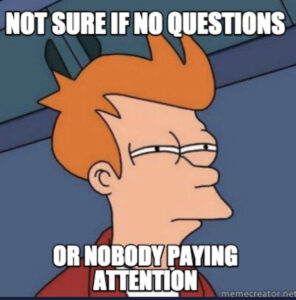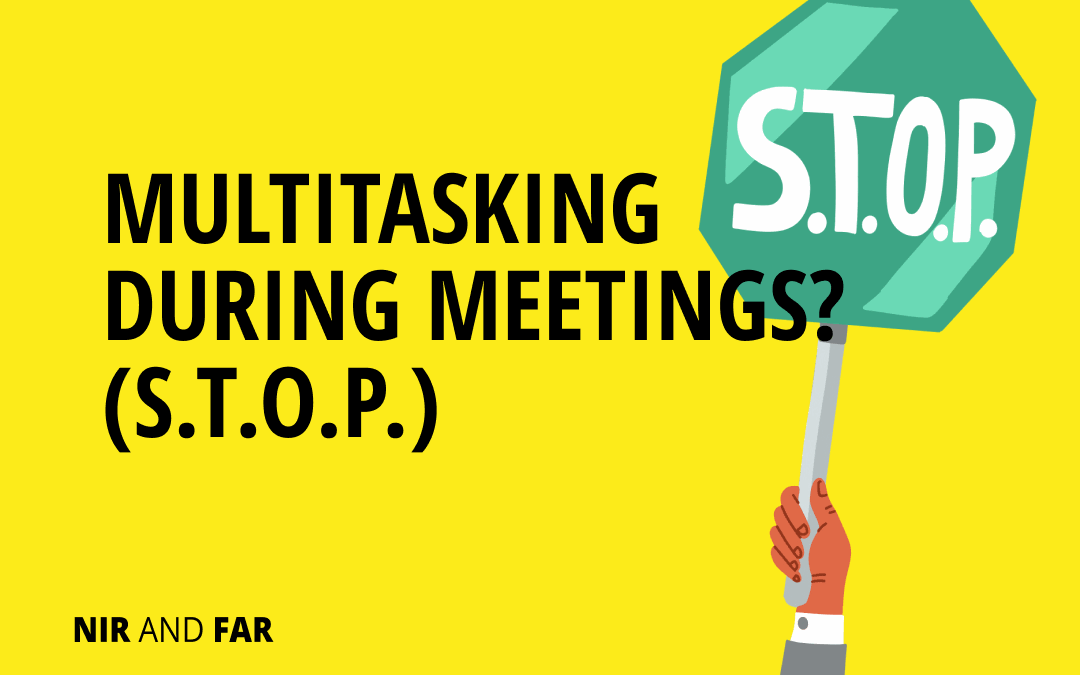Nir’s Note: This guest post is written by Jenny Wood, an author, speaker, founder of Google’s popular “Own Your Career” program. She writes for the Harvard Business Review, Entrepreneur, and her own blog.
When I moved from a Google sales team in New York City to a Google operations team in Boulder, Colorado several years ago, I expected to find differences in culture and team norms. But one particular practice took me by surprise. Multitasking during meetings was rampant. Everyone was so distracted.

This became grossly apparent during my first presentation in my new role.
The move had included a promotion: I had joined the leadership team in Boulder, and I had plenty of imposter syndrome. I was trying to prove myself—which is why I spent over seven hours preparing for my first big business review presented to my peers and manager.
As I presented my slides to half a dozen people in a corner conference room, my heart sank. My teammates occasionally glanced up at me, but mostly they spent the time managing their email inboxes. Even though the information I shared pertained to them, I barely had their attention.
Multitasking during meetings is common at most companies, but I’d never seen it as rampant as in this department. It was such a contrast to the team I was on just a few weeks prior in New York City.
I could see that my team and our performance would suffer if such workplace distractions continued. It was dysfunctional. So I did something about it.
Previously, I had read Nir Eyal’s book Indistractable, and I became a big fan of his ideas on distraction versus traction. He wrote that traction and distraction are categories of actions: Our actions either contribute to our progress (traction) or inhibit it (distraction).
Using Nir’s Indistractable model, I’d put energy into curbing my own distractions. I turned off alerts on my phone, tucked away my laptop during bedtime with my kids, and made progress on timeboxing my calendar.
The changes were easy, and I could see the payoff almost immediately. I was more present in the moment, and more focused at work and home. Changing my own multitasking behaviors was relatively simple since it required no buy-in from anyone but me.
However, when I thought about how to change these behaviors in my teammates, it felt daunting. Not only was I in a new leadership role, but also I didn’t yet have a rapport with my team.
How would I set about changing the work culture without seeming like I was dictating changes? How could I get them to understand the benefits and participate in the change?
With Nir’s Indistractable methods in mind, I designed a framework that encouraged people to stop multitasking during meetings—while including them in the decision to fight against distraction.
I came up with S.T.O.P., which stands for: Signal, Talk, Opt-out, and Pause.
People need role models. If everyone is tapping away at their keyboards while someone is speaking in a meeting, it’s easy to fall in line. However, if someone takes the lead on the behavior change, others might follow.
Nir noted that the Indistractable organizations he studied didn’t just have rules of workplace behavior; they had managers who exemplified the cultural norms. Leaders should practice what they preach and model disconnecting.
Taking this to heart, I kept my laptop closed during others’ presentations. While my teammates didn’t immediately follow suit, a colleague did comment (in front of everyone in the room) that they were inspired by how present I was in the meeting. These signals can truly start to shift culture over time.
Talk
I encouraged our team to talk. This was a huge part of making my teammates feel they were helping to build the new practices instead of just being on the receiving end of orders from me.
Creating a space for psychological safety was integral to getting them to talk openly.
Psychological safety, defined by organizational behavioral scientist Amy Edmondson, quoted in Nir’s book, is “a belief that one will not be punished or humiliated for speaking up with ideas, questions, concerns, or mistakes.”
Edmondson provides three steps for managers to achieve psychological safety:
- Frame an issue as “a learning problem, not an execution problem”
- Admit that you don’t have all the answers, that the problem is one you’ll all solve together; and
- “Model curiosity and ask questions”
At the next off-site meeting with my team, I reserved 20 minutes to discuss team norms. We batted around some challenges and ideas, and we agreed on new “bylaws” for meetings: for example, “Meetings begin on time even if only 30% of attendees are there,” and “Laptops down if someone is doing a formal presentation.”
One of the most popular norms we created was the “Opt-out.” We agreed that if someone had something urgent to tackle, they had a pass not to attend a meeting.
A crisis couldn’t be resolved quickly if the team member who could fix it had to spend 60 minutes in the weekly status meeting. Likewise, if they attended the meeting while dealing with a time-sensitive issue, they’d likely be too distracted to get value from the gathering.
Non-urgent meetings shouldn’t distract team members from important focused work.
Yet it’s hard to decline a team meeting, especially if your boss is leading it. “Opt-out” gave us the autonomy and the air cover to make smart decisions that best served the business and ourselves.
I began to take pregnant pauses when I presented, especially if I noticed people were not paying attention. This subtle trick is effective, without pointing fingers at any one person.
Sure, you could always stop mid-sentence and say, “Larry, I worked hard on this. These numbers are important for your team. Do you mind paying attention?” But that’s not something you’re likely to say to a peer, even if you’re frustrated.
A nice long pause reclaims people’s attention. The break makes them look up from their computers; when they do, they realize their mind has been elsewhere.
These four steps didn’t turn us into focus friends overnight. But we did make considerable progress. Team members became more discerning about when to be fully present. Plus, simply talking through how teammates should show up was a valuable exercise in building psychological safety to encourage future discussions.
We’re all busy, we all attend more meetings than we want, and we all have intimidating inboxes. But we often forget that the urge to chip away at those emails when we’re supposed to engage with others has a real downside. It hurts professional relationships, and it increases our stress if we’re trying to do multiple tasks at once. It also doesn’t serve you as a multitasker; when we’re distracted in a meeting, the output of that meeting is often lower quality.
So, let’s all band together to STOP distracted behavior. When we’re meeting, let’s meet, and when we’re working, let’s work.
Free Habit Tracker
Design your ideal day and build your best life.
Your email address is safe. I don't do the spam thing. Unsubscribe anytime. Privacy Policy.
Related Articles
- Schedule Maker: a Google Sheet to Plan Your Week
- Habit Tracker Template in Google Sheets
- The Ultimate Core Values List: Your Guide to Personal Growth
- Timeboxing: Why It Works and How to Get Started in 2024
- An Illustrated Guide to the 4 Types of Liars
- Hyperbolic Discounting: Why You Make Terrible Life Choices
- Happiness Hack: This One Ritual Made Me Much Happier

